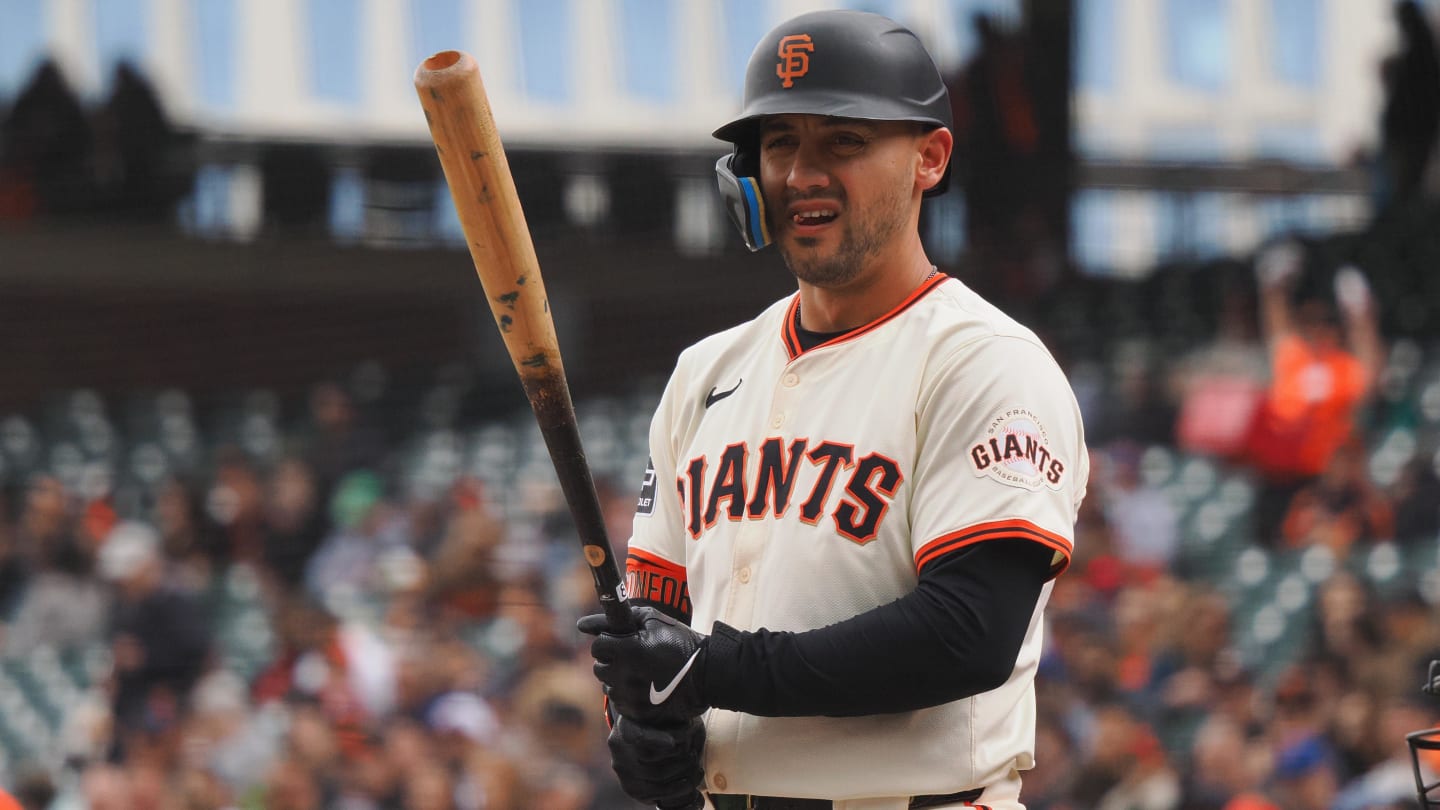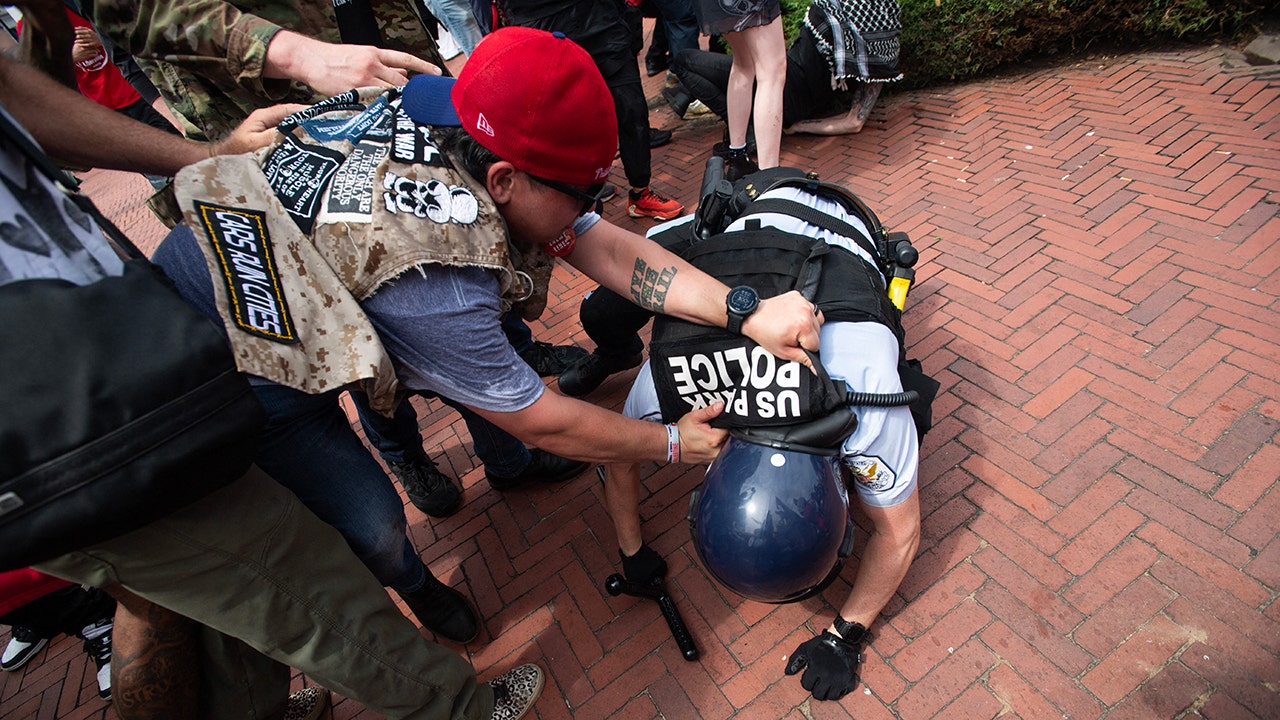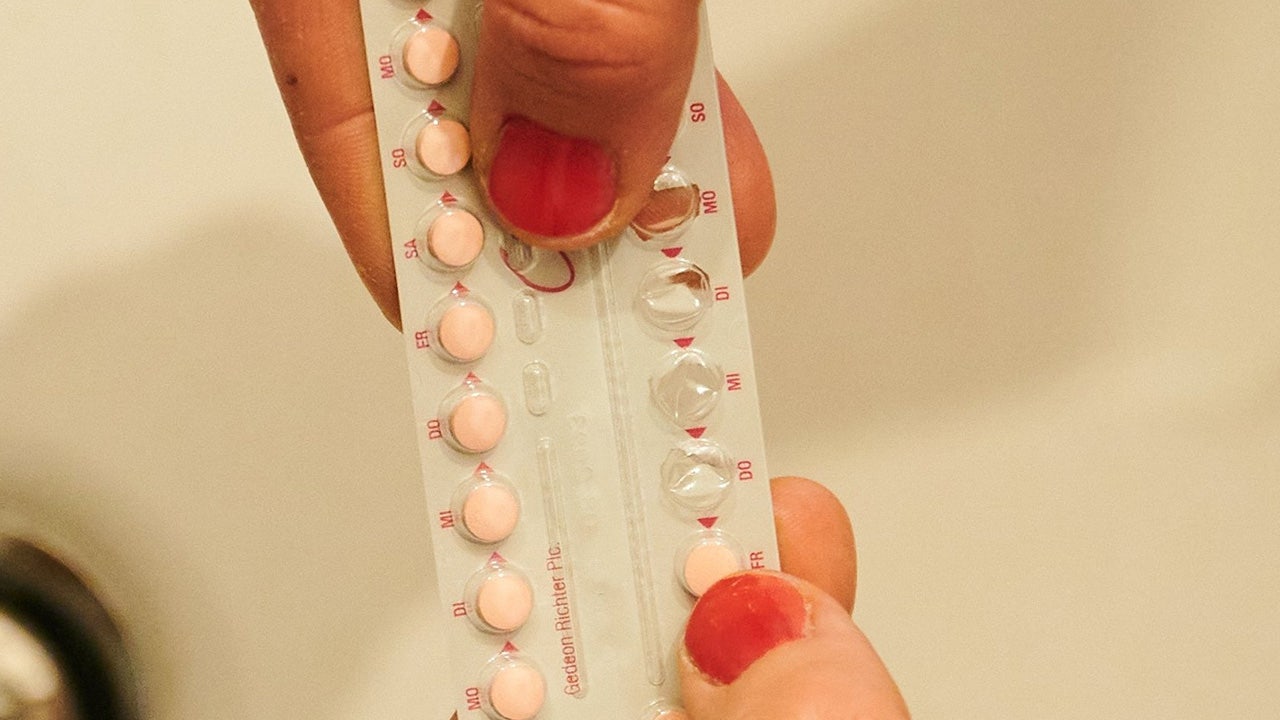Lifestyle
Where does L.A.’s leftover produce go? This group helps get tons to the hungry every day
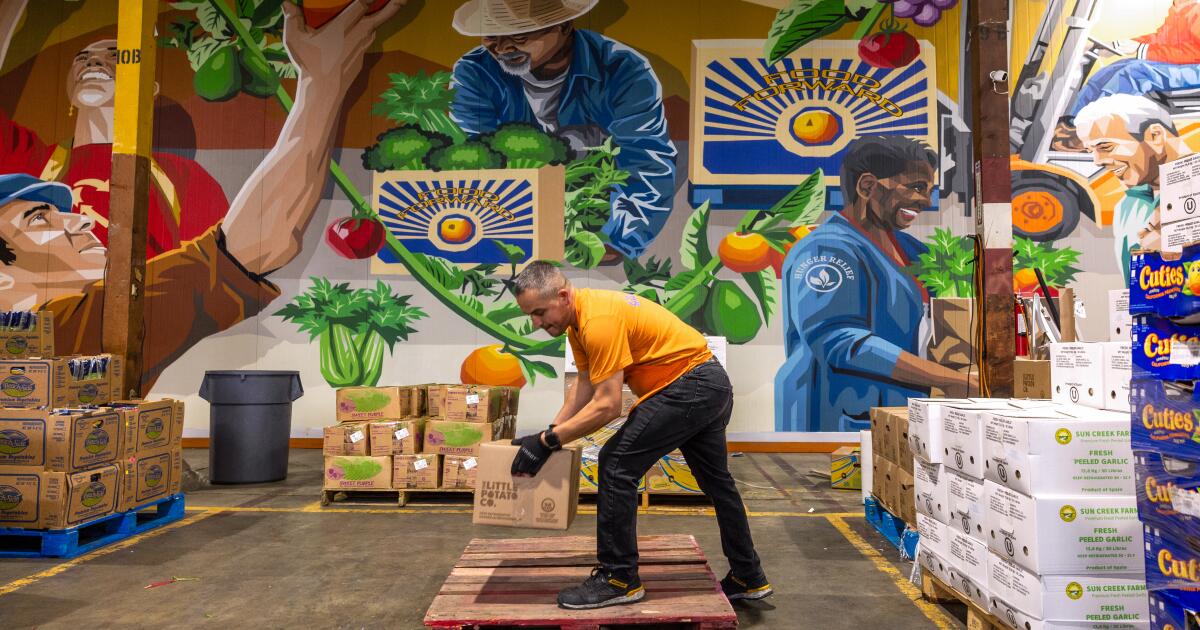
It’s 4:30 a.m. on a Tuesday and the lights are blazing at Food Forward’s Pit Stop warehouse. Big trucks are lining up waiting their turn while forklifts whiz around the loading dock, pulling pallets of donated asparagus, lettuce and strawberries off one truck or pushing boxes of purple potatoes, green beans and heirloom tomatoes onto another headed to needy clients later in the day.
Everything moves fast at Food Forward — a nonprofit devoted to redistributing produce that would otherwise go to waste — because fruits and veggies don’t last. When you’re moving tons of food at the edge of its usefulness — an average of 250,000 pounds or 125 tons every day — no one can afford to dawdle.
Lupe “Papi” Rodriguez uses plastic wrap to stabilize a wobbly pallet of unsold berries, tomatoes and other produce at the Los Angeles Wholesale Produce Market, before loading it into his truck bound for Food Forward’s warehouse.
(Jeanette Marantos / Los Angeles Times)
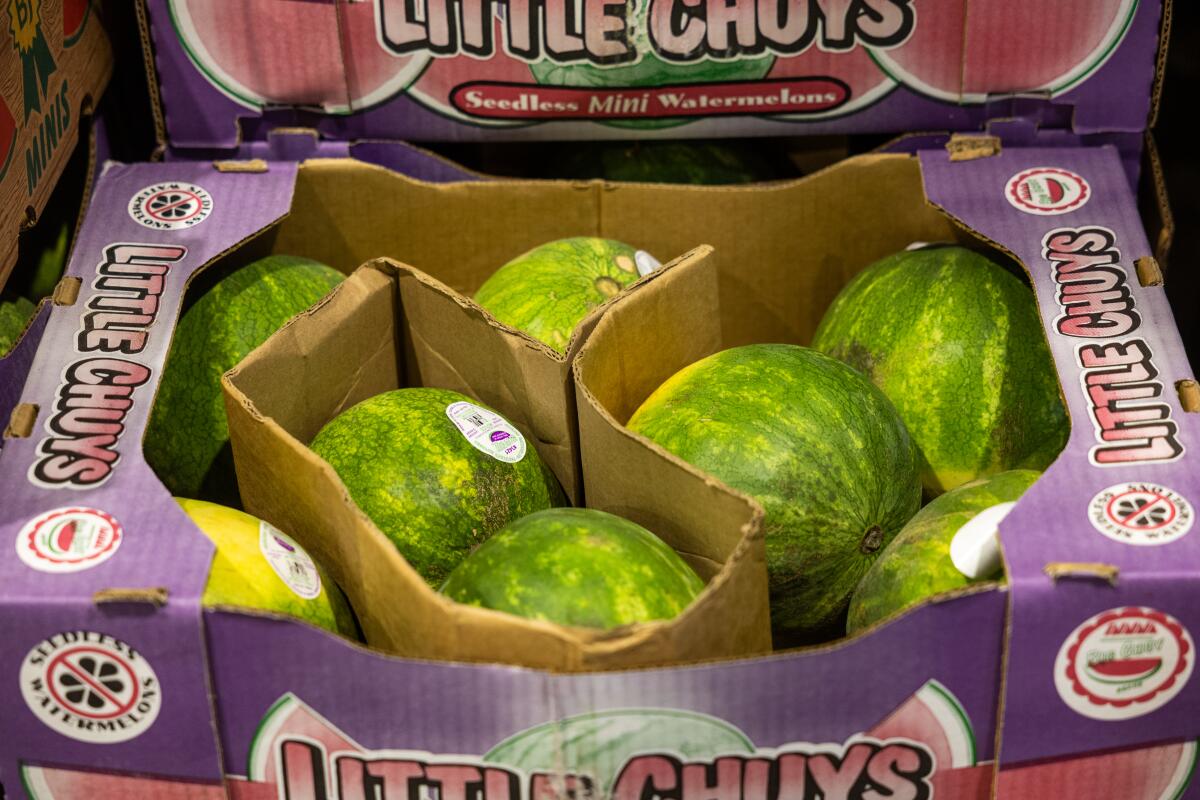
Mini watermelons are among the wide variety of fruit and vegetables brought into Food Forward’s warehouse.
(Myung J. Chun / Los Angeles Times)
The whole point of this hustle is to get food that would otherwise be wasted to hunger relief groups, who get the produce for free and must distribute it for free as well, without imposing any rules like listening to prayers, making donations or joining a club. Food Forward works with some 250 nonprofit groups to get it done, serving 13 counties in Southern and Central California along with seven states and tribal lands when there’s too much surplus for regional groups to handle.
So even though it’s dark and cold, Food Forward driver Lupe “Papi” Rodriguez is smiling as he gets ready to pick up pallets of unwanted fruits and veggies from wholesale produce vendors. “I enjoy my work,” said Rodriguez, who drove a produce truck for 20 years before joining Food Forward in 2021. “It’s a beautiful job, because you get to help people too.”
And it all started 15 years ago, when documentary photographer Rick Nahmias was nursing his ailing, elderly dog and a deep disappointment with politics. During their slow walks through his San Fernando neighborhood, Nahmias had lots of time to notice all the unpicked fruit on people’s trees, and consider how he could best proceed in helping the world.
The year before, Nahmias had worked hard on two political campaigns, to elect Barack Obama as the nation’s first Black president and to defeat Proposition 8, a state ballot initiative to ban gay marriage. Obama won, as did Proposition 8. Although the measure was later overturned, in January 2009 Nahmias was still aching. He and his husband had married just three years earlier, and the vote to ban their marriage “was pretty brutal,” he said.
“It felt like total whiplash, and I was so discouraged, I decided, ‘I can’t deal with politics anymore. I’ve got to go do something positive.’ And Food Forward was my way to turn the other cheek.”
It was also the height of the nation’s economic downturn, he said. “We were seeing long lines at food pantries, who didn’t have the storage to handle fresh fruit. These people were being forced to eat Cup of Noodles when just a mile away there were all these beautiful oranges and grapefruits hanging on trees … and I was thinking, ‘What’s wrong with this picture?’”
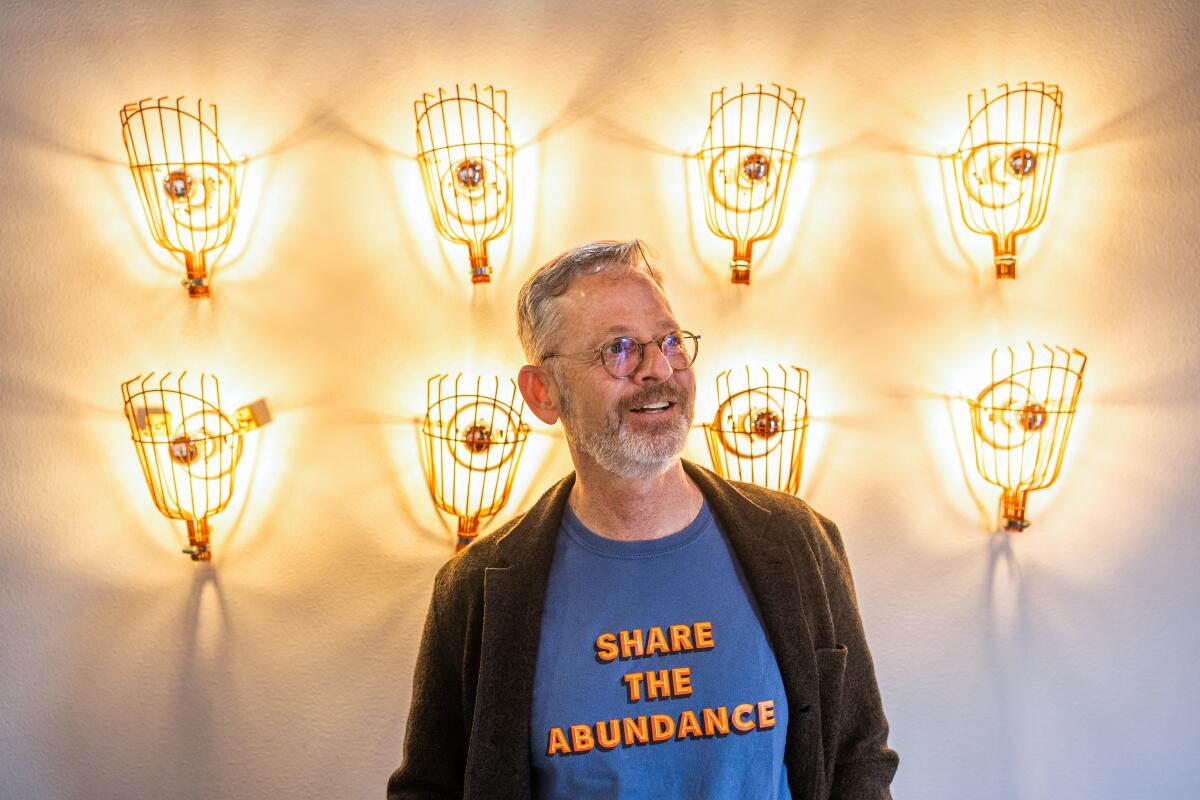
At the Food Forward warehouse, founder and CEO Rick Nahmias poses in front of a sculptural light display created from old fruit harvesting tools, which the organization still uses to glean unwanted fruit from residential trees.
(Myung J. Chun / Los Angeles Times)
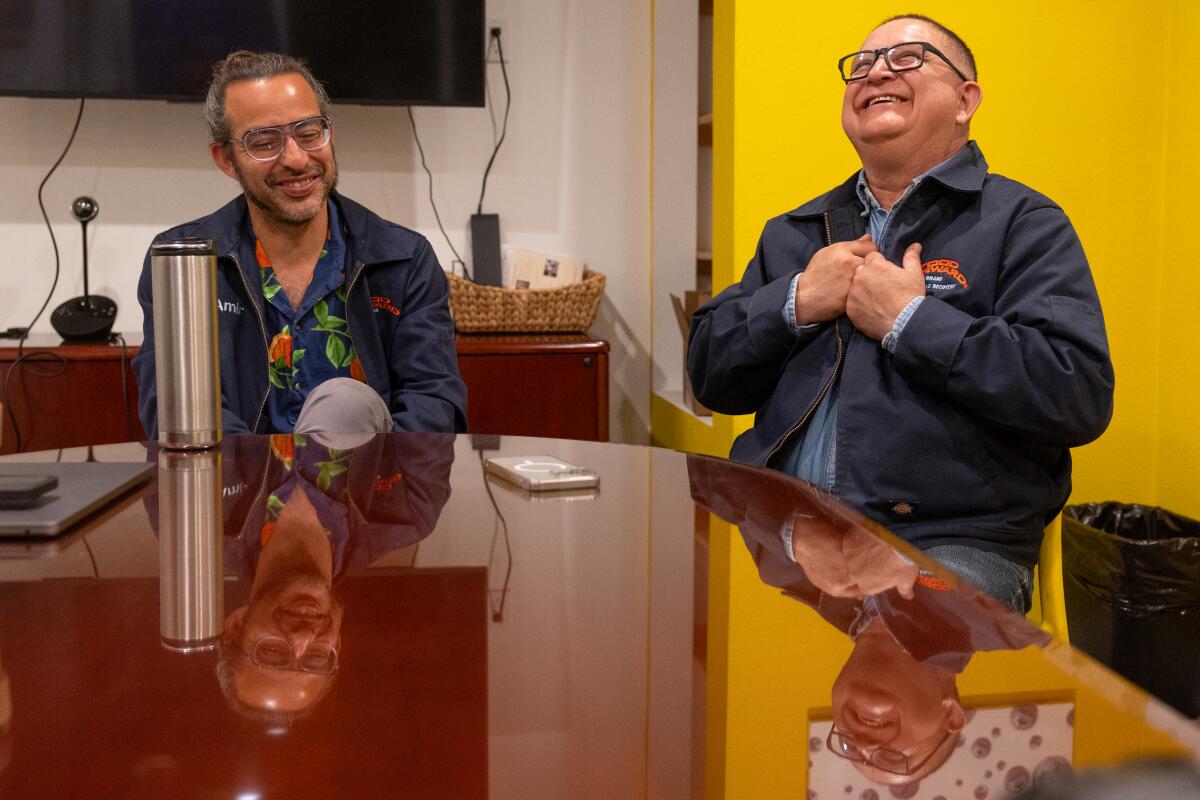
Warehouse manager Leo Paz, right, says it’s rewarding to help the community and to get paid for it as a job. On left is Amir Zambrano, managing director of wholesale recovery.
(Myung J. Chun / Los Angeles Times)
Addressing that imbalance was all Nahmias had in mind when he put an ad on Craigslist that January, asking for volunteers to help him pick unwanted fruit for donation. Six people responded, he said, but only one showed up at the first event. He persisted , and slowly, a group formed that picked 800 pounds of fruit off his neighbor’s tangerine and orange trees, and identified many more that needed picking.
That initial core group — Nahmias, Carl Buratti, Marie Boswell and Erica Kopmar — were all strangers who became close friends, “like a little tribe,” he said. For the next nine months they’d gather on weekends, picking fruit and delivering it to local food pantries. They did it to help people and build community, Nahmias said, but also because it was fun.
A community newspaper wrote a small article about their gleaning events, and in October 2009, while he was shopping for a Halloween costume, Nahmias got a call “out of the blue” from Evan Schlesinger of the Jewish Venture Philanthrophy Fund, offering him a $25,000 grant to see if his weekend “fun” could become a sustainable organization.
Nahmias thought the call was a prank at first, but after confirming it was real, the foursome hired consultants to review its viability. The verdict was yes, if they got nonprofit status and a strong leader, Nahmias said. His “tribe” sat him down and said, “‘This could go somewhere. We should do it,’ but when it came to leadership, they all took a step back.”
Thus Nahmias became the founder and CEO of Food Forward, a gleaning operation that distributed unwanted residential fruit to community organizations feeding needy people. But it didn’t take long for its scope to grow.
By 2012, farmers markets were reaching out to Food Forward, asking if its volunteers could help find a home for the produce left unsold. Farmers didn’t want to take it back, but no one wanted to see it thrown away. What began with the Santa Monica Farmers Market has grown to 16 farmers markets in Los Angeles and Ventura counties.
The biggest jump came in 2014, when Food Forward started working with wholesale produce sellers. “We set 300,000 pounds as our first goal, and ended up collecting 4.1 million pounds,” despite working with borrowed trucks and loading docks, and having to coax vendors to trust the food wouldn’t be resold, Nahmias said.
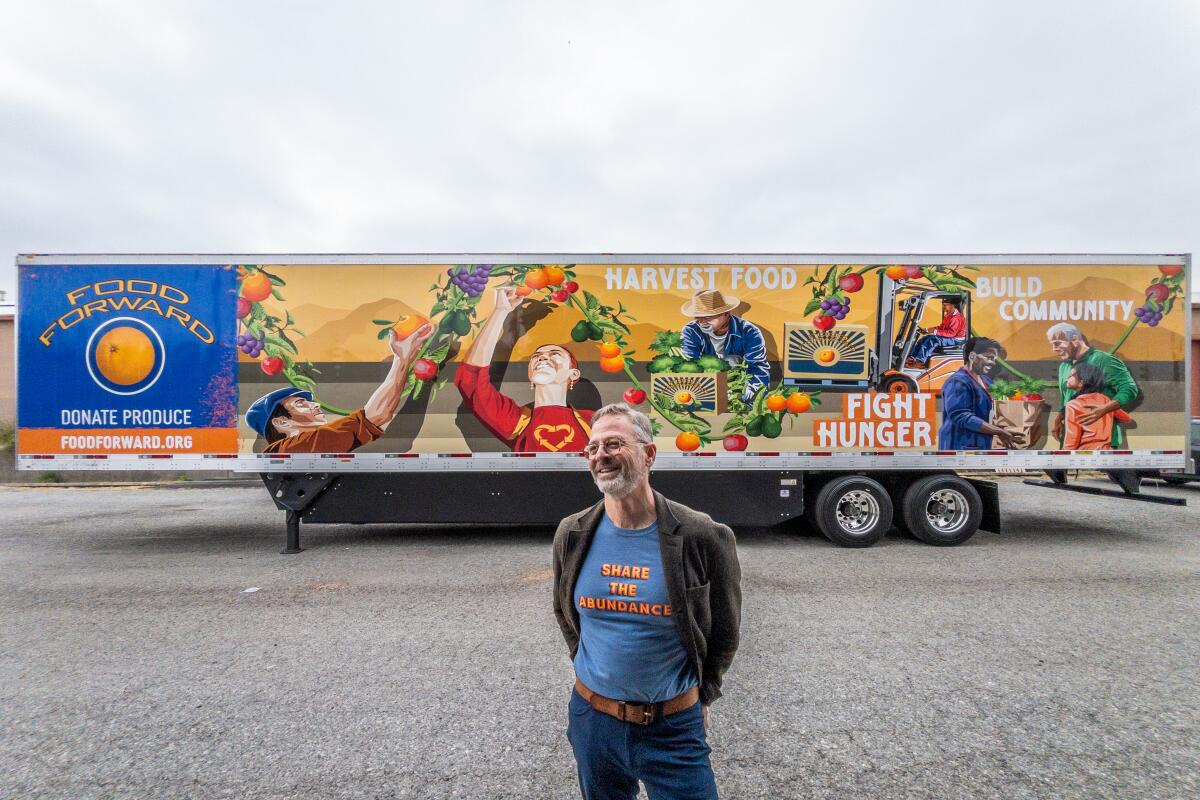
Rick Nahmias stands in front of a new trailer that the organization purchased to help with produce pickups.
(Myung J. Chun / Los Angeles Times)
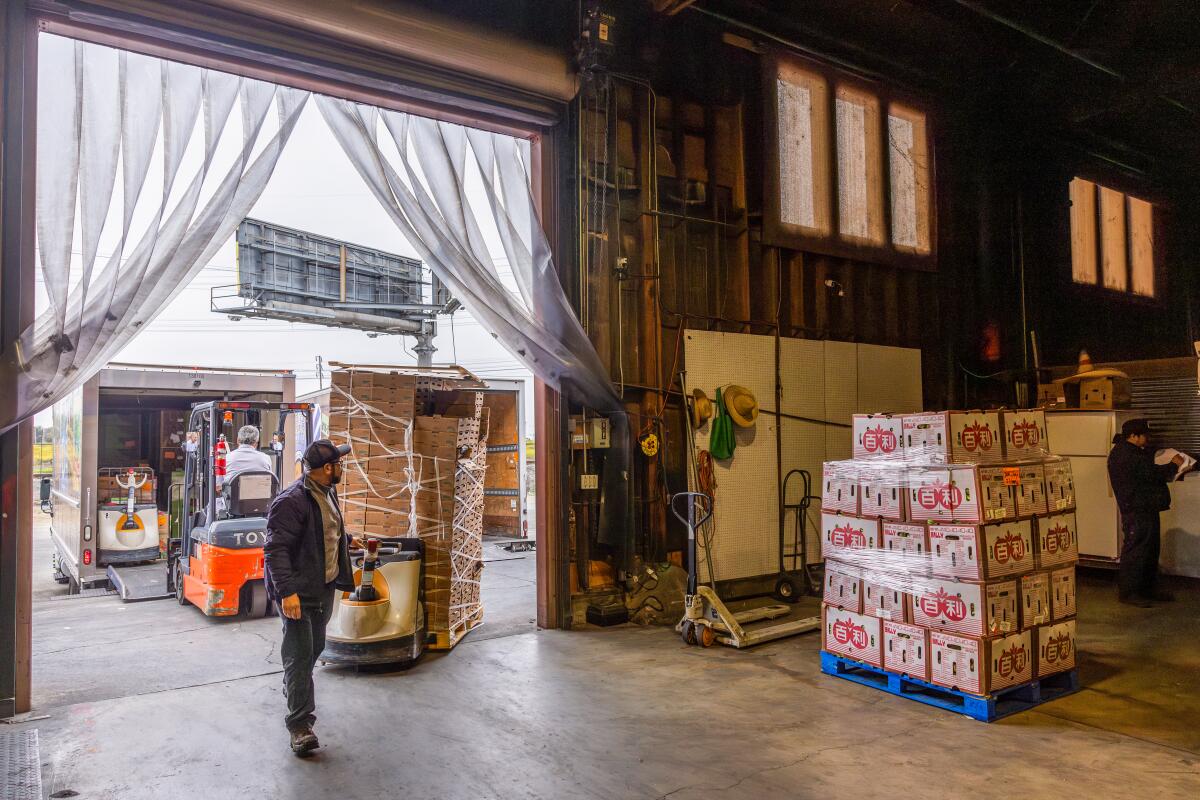
Driver Lupe Rodriguez brings in a pallet of produce he picked up during his early morning route.
(Myung J. Chun / Los Angeles Times)
Now, a decade later, Food Forward’s warehouse and its new giant truck trailer, pulled by an electric Volvo-made cab, features a mural by Brian Peterson depicting its three-pronged attack on hunger: gleaning, farmers markets and its Pit Stop warehouse in Bell, which in 2023 distributed 87 million pounds of free, unwanted produce primarily in Los Angeles County, on a budget of $6.3 million, or at a cost of 7 cents a pound.
The organization has about 50 employees and 2,000 volunteers. Its new goal — recognized by the White House — is to collect and donate 90 million pounds of produce this year, and 100 million pounds by 2025. Funding comes from grants and individual donations, “ranging from $5 to more than $1 million,” Nahmias said.
Back at the warehouse, Rodriguez disappears behind a forklift to unload his truck as warehouse manager Leo Paz congratulates Karlen Nurijanyan, founder and CEO of Student LunchBox, a nonprofit that provides food and other items to college students living in poverty. The group began in 2020, during the pandemic, and initially, Nurijanyan would pick up produce only from the warehouse’s smaller “Sprout” section, which provides boxes of fruits and veggies to groups too small to use big trucks.
This day, however, Nurijanyan has gotten funding to rent a truck big enough to use the Pit Stop loading dock, and he’s thrilled to be getting his first produce on pallets. During college, Nurijanyan was poor, with almost all his money going to rent. After college he got a corporate job but couldn’t shake the memory of his poverty and embarrassment.
When the pandemic forced him to stay at home, Nurijanyan knew it was time to pursue his dream of helping needy college students. Four years later, his group is serving around 4,000 students at 10 universities around L.A. County. The group distributes about 15,000 pounds of food every week, often in open-air “markets” where students can pick the produce they are most likely to eat. Food Forward’s support gave his little organization credibility with other donors, he said, and this year, his program is expanding to include donations of clothing, hygiene kits and other essentials.
This is why people want to work here, said Paz, watching Nurijanyan climb into his rented rig. Paz is all about relationships. He was already working with another hunger relief group when he learned about Food Forward’s growing to work with wholesale vendors. He knew he could have a bigger impact with Food Forward, and his expertise and warmth have helped it grow. Throughout the morning, Paz makes a point of greeting drivers and vendors by name, usually with handshakes that end in hugs.
These kinds of relationships are a large part of why Food Forward has been so successful, Nahmias said, and they must continue for the organization to get the staff and volunteers it needs to grow.
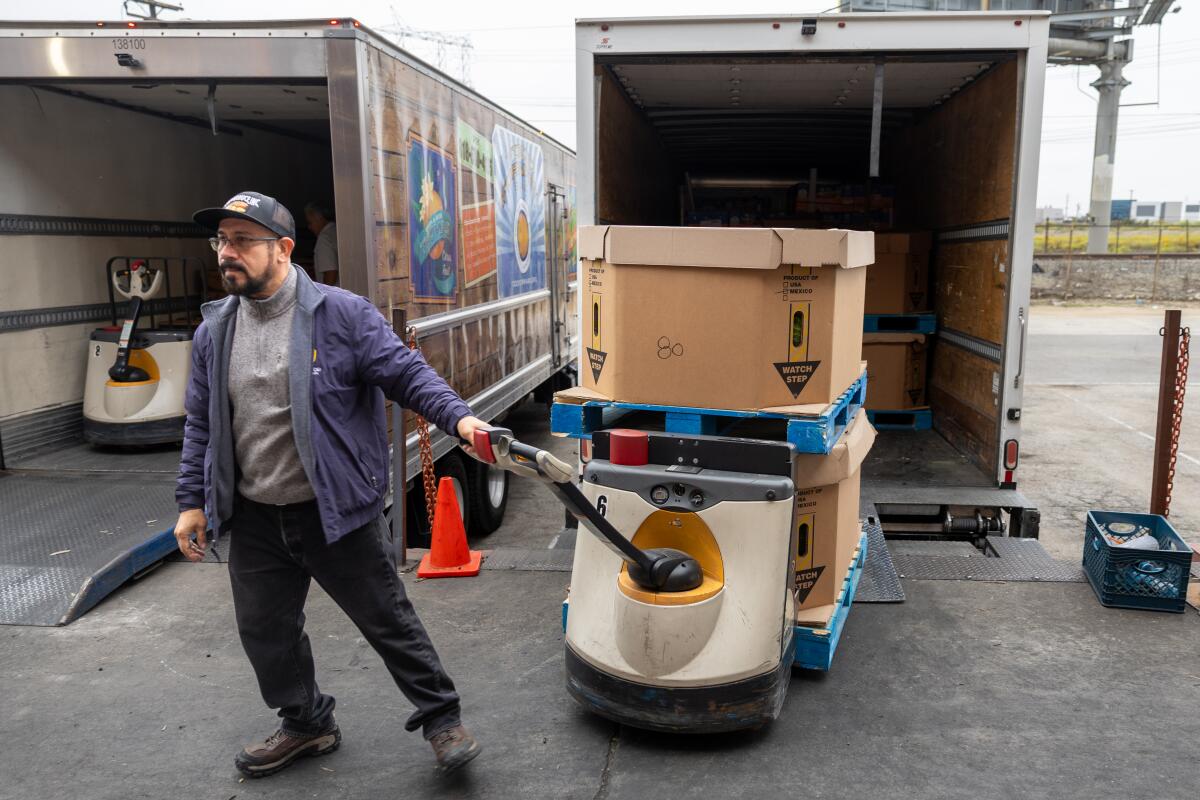
Driver Lupe Rodriguez unloads pallets of produce from his truck at Food Forward Produce Pit Stop.
(Myung J. Chun / Los Angeles Times)
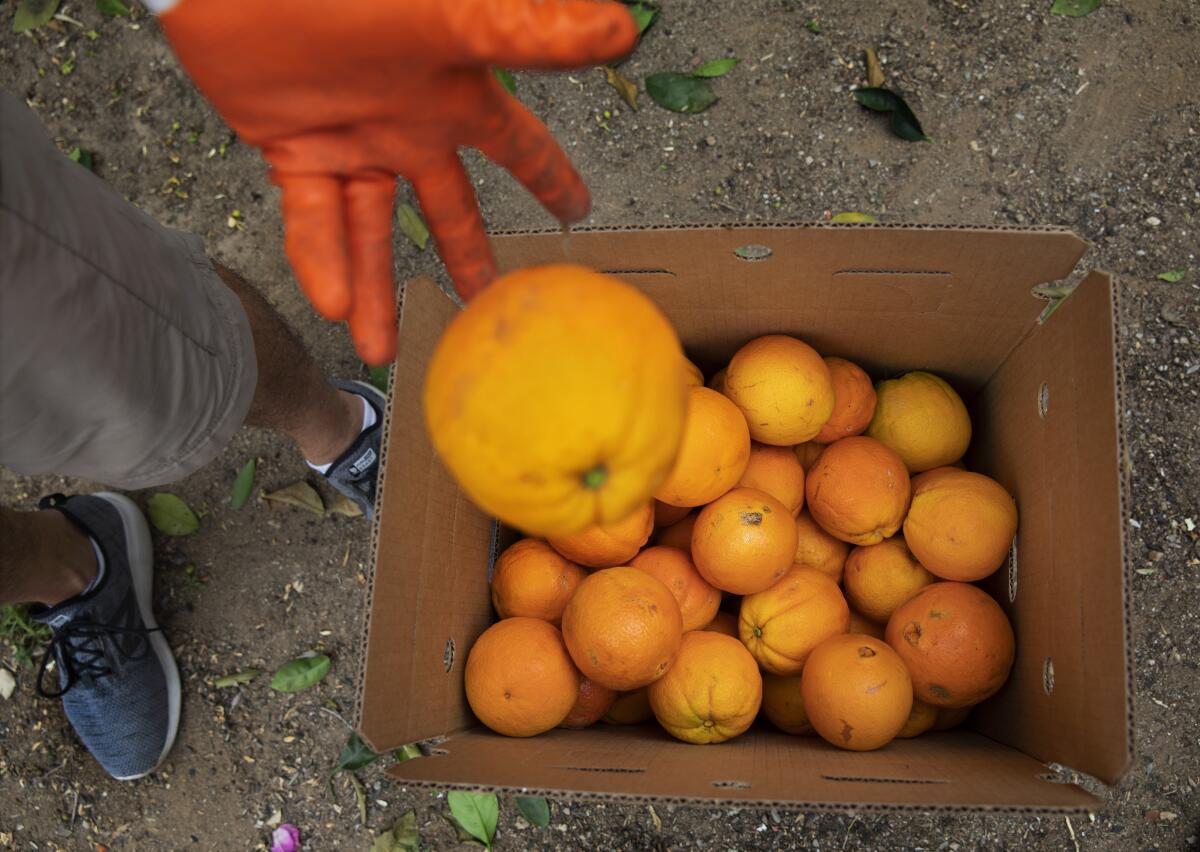
Typically, volunteers from Food Forward harvest thousands of trees, including these navel oranges, picked from a Newbury Park backyard in 2020.
(Mel Melcon / Los Angeles Times)
They’re working hard to bring in more volunteers, said Ally Forest, senior manager of community programs, especially those willing to be trained to lead gleaning and farmers market volunteers. People who are curious can participate in the group’s so-called Zestfest on June 1 at Cal State Northridge’s orange grove, where Food Forward will celebrate 15 years of gleaning fruit by inviting volunteers to harvest hundreds of citrus trees.
And then, after working nonstop since he began, Nahmias is taking a three-month sabbatical to travel, rejuvenate and plan for the future, since visioning is one of his biggest jobs these days.
“‘Share the abundance’ is not just a slogan, it’s a way of life,” he said. “We need to get people out of their own selfish ways and realize how much they have that they can share. It doesn’t have to be fruit; it could be money, time, love. … We all have abundance; we just need to find out what it is, and give it.”

Lifestyle
'Wait Wait' for July 27, 2024: With Not My Job guest Kathleen Hanna

Kathleen Hanna of The Julie Ruin performs onstage at the 2016 Panorama NYC Festival – Day 2 at Randall’s Island on July 23, 2016 in New York City. (Photo by Nicholas Hunt/Getty Images)
Nicholas Hunt/Getty Images/Getty Images North America
hide caption
toggle caption
Nicholas Hunt/Getty Images/Getty Images North America
This week’s show was recorded in Chicago with host Peter Sagal, judge and scorekeeper Bill Kurtis, Not My Job guest Kathleen Hanna and panelists Meredith Scardino, Peter Grosz, and Mo Rocca Click the audio link above to hear the whole show.
Who’s Bill This Time
Momala Takes Over; Assigned Seats Are Back; And The Heat Is On
The Olympic Torch Reporch
Our Summer Olympics Preview
Bluff The Listener
Our panelists tell three stories about someone committing an office faux pas, only one of which is true.
Not My Job: We quiz Bikini Kill’s Kathleen Hanna on Hanna-Barbera
Punk icon Kathleen Hanna plays our game called, “Kathleen Hanna Meet Hannah-Barbera.” Three questions about the animation studio.
Panel Questions
Hide Your Receipts; VR Meets ER; Avocado Apologies
Limericks
Bill Kurtis reads three news-related limericks: Situation Room Cocktails; Burrito Bird; Hopped Up Sharks
Lightning Fill In The Blank
All the news we couldn’t fit anywhere else
Predictions
Our panelists predict what will be the big story out of the Paris Olympic Games
Lifestyle
L.A. Affairs: At 77, I had a crush on my best friend’s widower. Did he feel the same way?
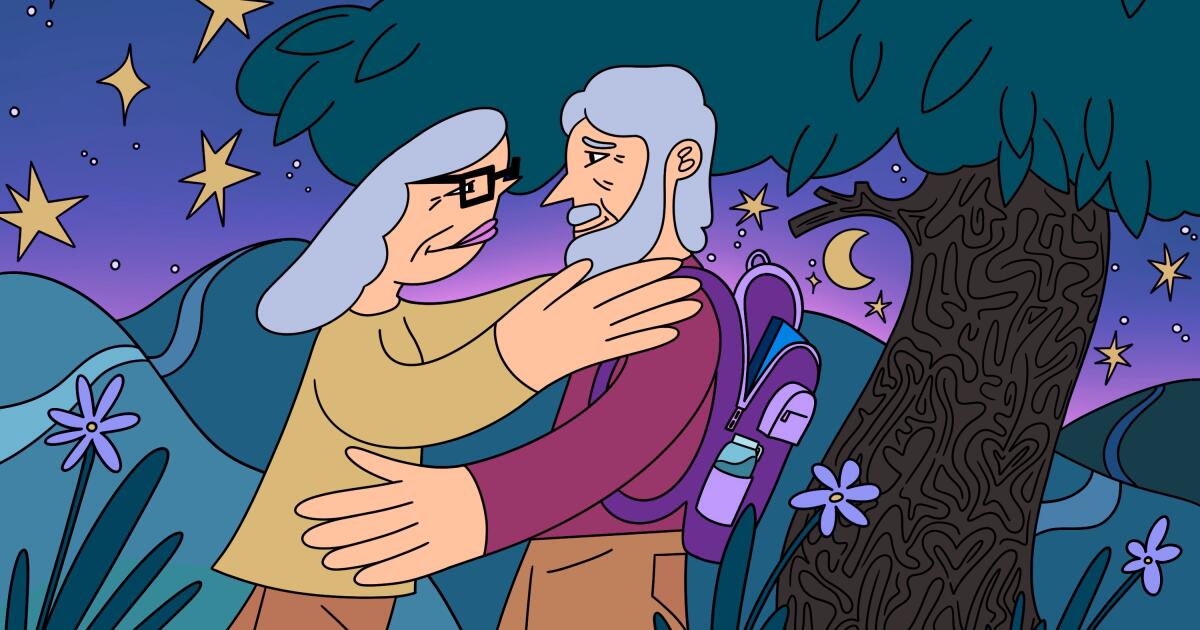
At 77, I had given up. After two failed marriages and years of unsuccessful dating, I accepted what seemed to be my fate: single for almost 40 years and single for however many remained. You don’t get it all, I told myself. I was grateful for family, friends and work. Life settled into what felt like order.
Until Ty.
As the husband of my best friend, he was no stranger, but he was usually peripheral. Then 10 years ago, my friend got lung cancer. I watched during visits, stunned at how nurturing Ty could be, taking care of her even though they had separated years before at her request.
After she died, Ty and I stayed in touch sporadically: a surprise sharing of his second granddaughter a year after we scattered my friend’s ashes, an invitation to the launch of my book a year later. Ty attended, hovering in the back, emerging after everyone left to attentively help load my car.
Two more years passed. During quiet moments, I remembered his sweetness. I also remembered his handsome face and long, tall body. Confused about what I wanted, I texted Ty, who’s an architect, under the guise of purchasing a tree for my backyard.
We spent an afternoon at the nursery, laughing, comparing options and agreeing on a final selection. When the tree arrived, I emailed a photo. He emailed a thank you.
Another three years passed, broken only by news of his third granddaughter and my memories of how good it felt to be with him. Alert to his attentiveness, but unsettled by both his remove and my growing interest, I risked reaching out again, this time about remodeling my garage.
Ty spent several hours at my house making measurements, checking the foundation and sharing pictures of his home in Topanga. His sketches for the garage arrived two weeks later via email.
I was grateful for his help but unsure over what sort of friendship we were developing, at least from his point of view. I, however, was clear. I wanted him to wrap his long arms around me, tell me sweet things and make me his.
Instead, I sent a gift card to a Topanga restaurant to thank him for his drawings.
“Maybe we should spend it together,” he texted.
We dined in the dusk of late summer. Our talk was easy. Discomfort lay in the unspoken. Anxious for clarity, I repeatedly let my hand linger near the candle flickering in the middle of our table. It remained untouched.
And that was as far as I was willing to go. I refused to be any more forward, having already compromised myself beyond my comfort level with what seemed, at least to me, embarrassingly transparent efforts to indicate my interest. Not making the first move was very important. If a man could not reach out, if he didn’t have the self-confidence to take the first step, he would not, I adamantly felt, be a good partner for me.
Two weeks later, Ty did email, suggesting an early evening hike in Tuna Canyon in Malibu. The setting was perfect. Sun sparkled off the ocean. A gentle breeze blew. We climbed uphill for sweeping coastal vistas and circled down to the shade of live oaks, touching only when he took my hand to steady me where the path was slippery. At the end of the trail, overlooking the juncture between the mountains and the sea, we stood opposite each other and talked animatedly for almost an hour, both of us reluctant to part.
Our conversation was engaging, but my inner dialogue was louder. When, I kept thinking, is this man going to suggest we continue the evening over dinner? We didn’t have to go out. We could eat at his house. It was 7 p.m., for God’s sake. Passing hikers even stopped to remark on our matching white hair and how well they thought we looked together. It was like a movie scene where the audience is yelling, “Kiss her, kiss her,” rooting for what they know is going to happen while the tension becomes almost unbearable. But bear it I did.
Each of us ate alone.
A few weeks later, at his suggestion, we were back at Tuna Canyon. This time Ty did invite me to end the evening at his house. Sitting close on his couch, but not too close, we drifted toward each other in the darkening room. His shoulder brushed mine reaching for his cup of coffee. My hip pressed his as I leaned in for my tea. Slowly, sharing wishes and hopes for our remaining years, we became shadows in the light of the moon. And in that darkness, in that illuminated space, he reached out.
This reticent man, this man who was so slow to move toward me, this sensitive man who hid himself behind layers so opaque I was unsure of his interest, released all that he had inside him.
“I wanted you,” Ty repeated again and again. “I was afraid of ruining things. You were her best friend. I didn’t want to lose your friendship.”
Our pent-up tension exploded.
Stunned and thrilled, I leaned into the space he opened.
Three years later, it is a space we continue to share: a place where neither of us has given up, a place where he wraps me in his long arms, a place we hold carefully against our diminishing days.
The author is the owner of a preschool in Venice as well as a psychotherapist, photographer and writer. Her first book, “Naked in the Woods: My Unexpected Years in a Hippie Commune,” was published in 2015. Her newest manuscript, “Bargains: A Coming of Aging Memoir Told in Tales,” is seeking a publisher. She lives in Mar Vista and can be found at margaretgrundstein.com, Instagram @margwla, Medium @margaretgrundstein and Substack @mgrundstein.
L.A. Affairs chronicles the search for romantic love in all its glorious expressions in the L.A. area, and we want to hear your true story. We pay $400 for a published essay. Email LAAffairs@latimes.com. You can find submission guidelines here. You can find past columns here.
Lifestyle
'Deadpool & Wolverine' is a self-cannibalizing slog

Ryan Reynolds stars as Deadpool and Hugh Jackman as Wolverine in an odd-couple action hero pairing.
Jay Maidment/20th Century Studios
hide caption
toggle caption
Jay Maidment/20th Century Studios
When Fox Studios released the first Deadpool movie back in 2016, it played like an irreverently funny antidote to our collective comic-book-movie fatigue. Wade Wilson, or Deadpool, was a foul-mouthed mercenary who obliterated his enemies and the fourth wall with the same gonzo energy.
Again and again, Deadpool turned to the camera and mocked the clichés of the superhero movie with such deadpan wit, you almost forgot you were watching a superhero movie. And Ryan Reynolds, Hollywood’s snarkiest leading man, might have been engineered in a lab to play this vulgar vigilante. I liked the movie well enough, though one was plenty; by the time Deadpool 2 rolled around in 2018, all that self-aware humor had started to seem awfully self-satisfied.
Now we have a third movie, Deadpool & Wolverine, which came about through some recent movie-industry machinations. When Disney bought Fox a few years ago, Deadpool, along with other mutant characters from the X-Men series, officially joined the franchise juggernaut known as the Marvel Cinematic Universe.
That puts the new movie in an almost interesting bind. It tries to poke fun at its tortured corporate parentage; one of the first things Deadpool says is “Marvel’s so stupid.” But now the movie also has to fit into the narrative parameters of the MCU. It tries to have it both ways: brand extension disguised as a satire of brand extension.

It’s also an odd-couple comedy, pairing Deadpool with the most famous of the X-Men: Logan, or Wolverine, the mutant with the unbreakable bones and the retractable metal claws, played as ever by a bulked-up Hugh Jackman.
The combo makes sense, and not just because both characters are Canadian. In earlier movies, Deadpool often made Wolverine the off-screen butt of his jokes. Both Deadpool and Wolverine are essentially immortal, their bodies capable of self-regenerating after being wounded. Both are tormented by past failures and are trying to redeem themselves. Onscreen, the two have a good, thorny chemistry, with Jackman’s brooding silences contrasting nicely with Reynolds’ mile-a-minute delivery.
I could tell you more about the story, but only at the risk of incurring the wrath of studio publicists who have asked critics not to discuss the plot or the movie’s many, many cameos. Let’s just say that the director Shawn Levy and his army of screenwriters bring the two leads together through various rifts in the multiverse. Yes, the multiverse, that ever-elastic comic-book conceit, with numerous Deadpools and Wolverines from various alternate realities popping up along the way.

I suppose it’s safe to mention that Matthew Macfadyen, lately of Succession, plays some kind of sinister multiverse bureaucrat, while Emma Corrin, of The Crown, plays a nasty villain in exile. It’s all thin, derivative stuff, and the script’s various wink-wink nods to other shows and movies, from Back to the Future to Furiosa to The Great British Bake Off, don’t make it feel much fresher. And Levy, who previously directed Reynolds in the sci-fi comedies Free Guy and The Adam Project, doesn’t have much feel for the splattery violence that is a staple of the Deadpool movies. There’s more tedium than excitement in the characters’ bone-crunching, crotch-stabbing killing sprees, complete with corn-syrupy geysers of blood.

For all its carnage, its strenuous meta-humor and an R-rated sensibility that tests the generally PG-13 confines of the MCU, Deadpool & Wolverine does strive for sincerity at times. Some of its cameos and plot turns are clearly designed to pay tribute to Fox’s X-Men films from the early 2000s.
As a longtime X-Men fan myself, I’m not entirely immune to the charms of this approach; there’s one casting choice, in particular, that made me smile, almost in spite of myself. It’s not enough to make the movie feel like less of a self-cannibalizing slog, though I suspect that many in the audience, who live for this kind of glib fan service, won’t mind. Say what you will about Marvel — I certainly have — but it isn’t nearly as stupid as Deadpool says it is.

-

 World1 week ago
World1 week agoOne dead after car crashes into restaurant in Paris
-

 Midwest1 week ago
Midwest1 week agoMichigan rep posts video response to Stephen Colbert's joke about his RNC speech: 'Touché'
-

 News1 week ago
News1 week agoVideo: Young Republicans on Why Their Party Isn’t Reaching Gen Z (And What They Can Do About It)
-

 Movie Reviews1 week ago
Movie Reviews1 week agoMovie Review: A new generation drives into the storm in rousing ‘Twisters’
-

 News1 week ago
News1 week agoIn Milwaukee, Black Voters Struggle to Find a Home With Either Party
-
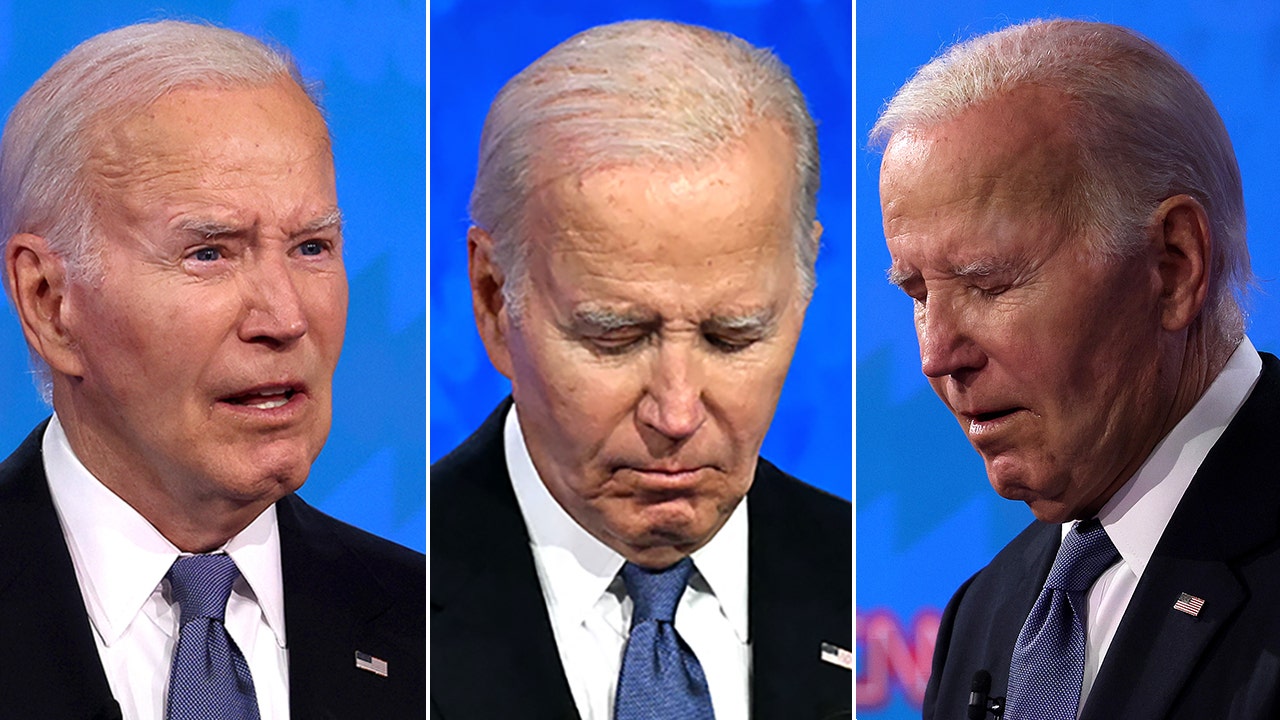
 Politics1 week ago
Politics1 week agoFox News Politics: The Call is Coming from Inside the House
-

 News1 week ago
News1 week agoVideo: J.D. Vance Accepts Vice-Presidential Nomination
-

 World1 week ago
World1 week agoTrump to take RNC stage for first speech since assassination attempt




